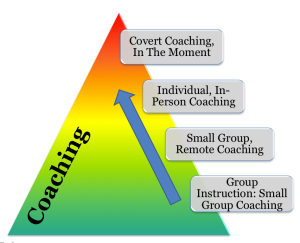 ASD On The Go uses a continuum of intensity of coaching as a key component of intervention for individuals with autism. Coaching is a form of intervention that involves a parent, teacher, paraprofessional, supervisor, coach, or other person working with an individual on a regular basis to develop and maintain specific skills. During coaching, individuals learn the difference between appropriate and inappropriate behaviors. Coaching may include providing/receiving direct feedback, modeling of appropriate behaviors, and engaging in practice scenarios. Coaching sessions may vary from multiple meetings a week to meeting monthly, depending on the individual’s needs. With ASD On The Go, coaching may occur through electronic communication, telephone, videoconference, or in person.
ASD On The Go uses a continuum of intensity of coaching as a key component of intervention for individuals with autism. Coaching is a form of intervention that involves a parent, teacher, paraprofessional, supervisor, coach, or other person working with an individual on a regular basis to develop and maintain specific skills. During coaching, individuals learn the difference between appropriate and inappropriate behaviors. Coaching may include providing/receiving direct feedback, modeling of appropriate behaviors, and engaging in practice scenarios. Coaching sessions may vary from multiple meetings a week to meeting monthly, depending on the individual’s needs. With ASD On The Go, coaching may occur through electronic communication, telephone, videoconference, or in person.
Below are several examples of studies that examine the effectiveness of coaching:
- Bennett, K., Ramasamy, R., Honsberger, T. (2013). The effects of covert audio coaching on teaching clerical skills to adolescents with autism spectrum disorder. Journal of Autism and Developmental Disorders, 43, 585-593.
- This study assisted three high school students with ASD in their natural high school setting. The study focused on assisting students with clerical skills through the utilization of covert audio coaching. The study demonstrated covert audio coaching was successful in increasing the participants’ accuracy in making photocopies and demonstrated these gains were maintained for several weeks following the end of the intervention.
- Weiss, A., & Robland, P. (2015). Implementing a communication coaching program for students with autism spectrum disorders in postsecondary education. Topics in Language Disorders, 35(4), 345-361.
- This article discusses how disability counselors, communication coaches, and peer coaches implemented social-communication coaching with postsecondary students. Insights regarding the authors’ findings over a five-year period are provided.
- Wentz, E., & Krevers, N. (2012). Development of an internet-based support and coaching model for adolescents and young adults with ADHD and autism spectrum disorders: A pilot study. European Child and Adolescent Psychiatry, 21, 611-622.
- This study contained 10 individuals who ranged in age from 15-26 who had a diagnosis of ADHD and/or Autism. Participants completed 8-weeks of Internet based coaching. The content of coaching was individualized based on individual’s needs. The authors note the coaches often recommended strategies to manage daily living. Participants demonstrated an improvement in self-reported self-esteem and subjective quality of life.
- Gilson, C., & Carter, E. (2016). Promoting social interactions and job independence for college students with autism or intellectual disability: A pilot study. Journal of Autism and Developmental Disorders, 46(11), 3583-3596.
- This study examines the effects of a coaching package on social interactions and task engagement for 3 students enrolled in a midsized university. All students worked 4-8 hours at individual internships where the live coaching was to take place. All participants demonstrated an increase in social interactions and task engagement was maintained. Overall, the participants reported the coaching package was unobtrusive.
